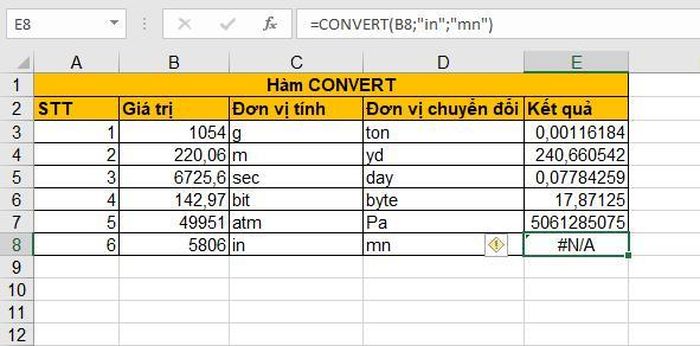Introducing how to use the CONVERT function in Excel in the most detail
CONVERT function structure in Excel
The CONVERT function supports converting a number of measurement units such as weight, volume, distance, time, pressure, force, energy, power, magnetism, temperature, volume, area, information…
Function syntax: =CONVERT(number; from_unit; to_unit)
In there:
number : Required argument, is the value in from_units to convert.
from_unit : Required argument, which is the unit of number .
to_unit : Required argument, is the unit you want to convert to.
Attention:
If the input data type is incorrect -> the function returns the #VALUE! error value.
If the unit does not exist -> the function returns the #N/A error value.
If the unit does not support binary prefixes -> the function returns the #N/A error value.
If form_unit, to_unit do not belong to the same group of measurement units -> the function returns the error value #N/A.
Unit names and prefixes are case sensitive.
How to use the CONVERT function in Excel
For example, we have a table of values and units that need to be converted as follows:

Number 1: We need to convert 1054 grams to tons. In cell E3 we have the formula: =CONVERT(B3;'g';'ton')
We get the result: 1054 grams = 0.001161836 tons
Number 2: We need to convert 220.06 meters to yards. In cell E4 we have the formula: =CONVERT(B4;'m';'yd')
We get the result: 220.06 meters = 240.6605424 yards
Similarly, the 3rd number is the conversion from seconds to days, the 4th number is the conversion from bits to bytes, the 5th number is the conversion from atmosphere degrees to pascal degrees.
With the 6th number, it converts from inches to millimeters. Because these two units are not in the same unit group, they cannot be converted. At this point, Excel will report the #N/A error .

You should read it
- How to convert CSV files to Excel in bulk
- How to convert money into words in Excel, without an add-in, supports both 32-bit and 64-bit Excel
- How to convert PDF to Excel
- How to convert columns into rows and rows into columns in Excel
- How to use the Convert function on Excel
- How to convert Cad to Word, PDF, Excel
- How to convert PDF files to Excel keeps formatting
- How to Convert Measurements Easily in Microsoft Excel
May be interested
- DATE Function: Converts numbers to a valid date format
 the date function in excel is a useful and most commonly used function. let's learn how to use the date function in excel with tipsmake.com.com!
the date function in excel is a useful and most commonly used function. let's learn how to use the date function in excel with tipsmake.com.com! - Instructions for using the COUNTBLANK function in Excel
 in excel, the countblank function helps users count the number of blank cells in a given data range. this function is useful in checking for missing data, processing reports and statistics. this article will guide you in detail on how to use countblank, with practical examples.
in excel, the countblank function helps users count the number of blank cells in a given data range. this function is useful in checking for missing data, processing reports and statistics. this article will guide you in detail on how to use countblank, with practical examples. - How to use the LEN function in Excel
 the len function in excel is used to measure the length of a certain string of characters, including spaces and correctly return the total character for the user.
the len function in excel is used to measure the length of a certain string of characters, including spaces and correctly return the total character for the user. - Lost Paste Special function in Excel - How to find it again?
 losing the paste special function in excel is a mistake that makes you 'sweat'. learn how to fix this situation in detail in the article
losing the paste special function in excel is a mistake that makes you 'sweat'. learn how to fix this situation in detail in the article - Excel compatible function
 the following article introduces in detail the functions that are in the compatible function group in excel.
the following article introduces in detail the functions that are in the compatible function group in excel. - How to use COUNTIF function on Excel
 the countif function on excel is the cell count function to satisfy the given condition, often used in statistics tables.
the countif function on excel is the cell count function to satisfy the given condition, often used in statistics tables. - How to use the MOD function and QUOTIENT function in Excel
 injury in excel has many ways of doing it, can be used manually or using the calculation function.
injury in excel has many ways of doing it, can be used manually or using the calculation function. - 8 little-known Excel functions that can save you a lot of work
 even seasoned excel users often find themselves stuck performing tasks manually that could be automated with a few clever functions.
even seasoned excel users often find themselves stuck performing tasks manually that could be automated with a few clever functions. - How to use MID functions to get strings in Excel
 mid function in excel is a function that takes the middle character string corresponding to the value that the user requires to perform.
mid function in excel is a function that takes the middle character string corresponding to the value that the user requires to perform. - Simple way to convert Excel files to PDF - Convert directly or use software
 converting excel files to pdf will help create more professional documents, preventing spreadsheets from being modified during the exchange process. so how to convert excel to pdf?
converting excel files to pdf will help create more professional documents, preventing spreadsheets from being modified during the exchange process. so how to convert excel to pdf?










 Instructions on how to fix 'This workbook contains links to one or more external sources that could be unsafe' error in Excel
Instructions on how to fix 'This workbook contains links to one or more external sources that could be unsafe' error in Excel Tips for turning off suggestions in Excel, disabling the prediction feature in Excel simply
Tips for turning off suggestions in Excel, disabling the prediction feature in Excel simply How to use the Rate function in Excel to calculate loan interest rates is extremely simple
How to use the Rate function in Excel to calculate loan interest rates is extremely simple Instructions on 2 simple ways to delete conditional rows in Excel
Instructions on 2 simple ways to delete conditional rows in Excel Tell you how to turn off security warnings in Excel in the simplest and most detailed way
Tell you how to turn off security warnings in Excel in the simplest and most detailed way How to delete PDF pages extremely quickly
How to delete PDF pages extremely quickly